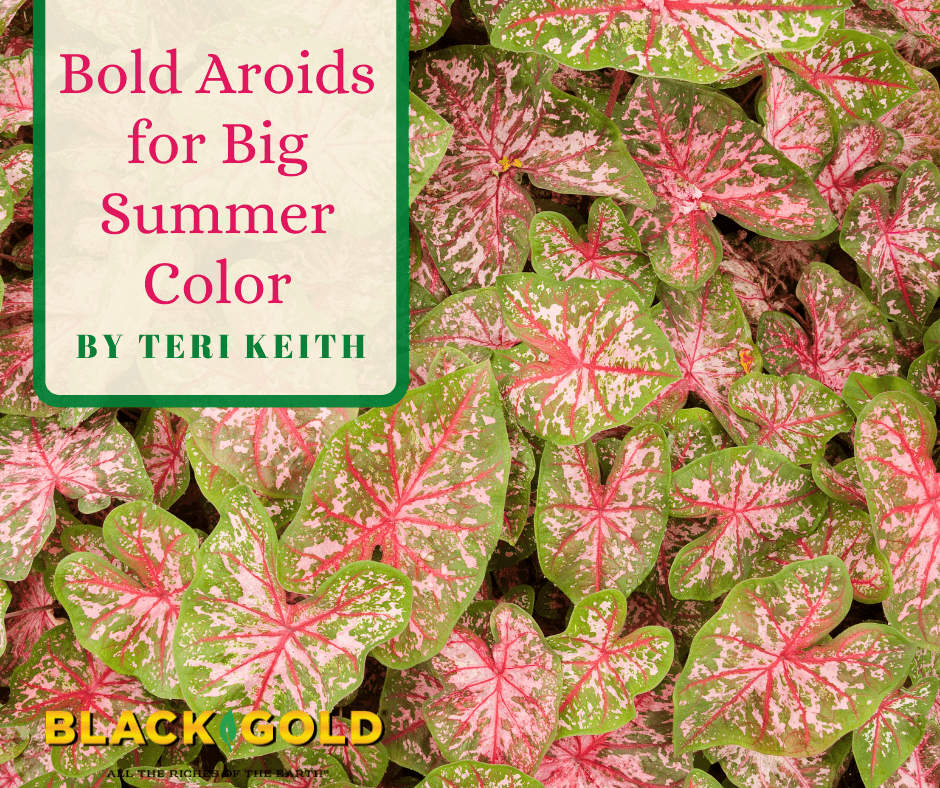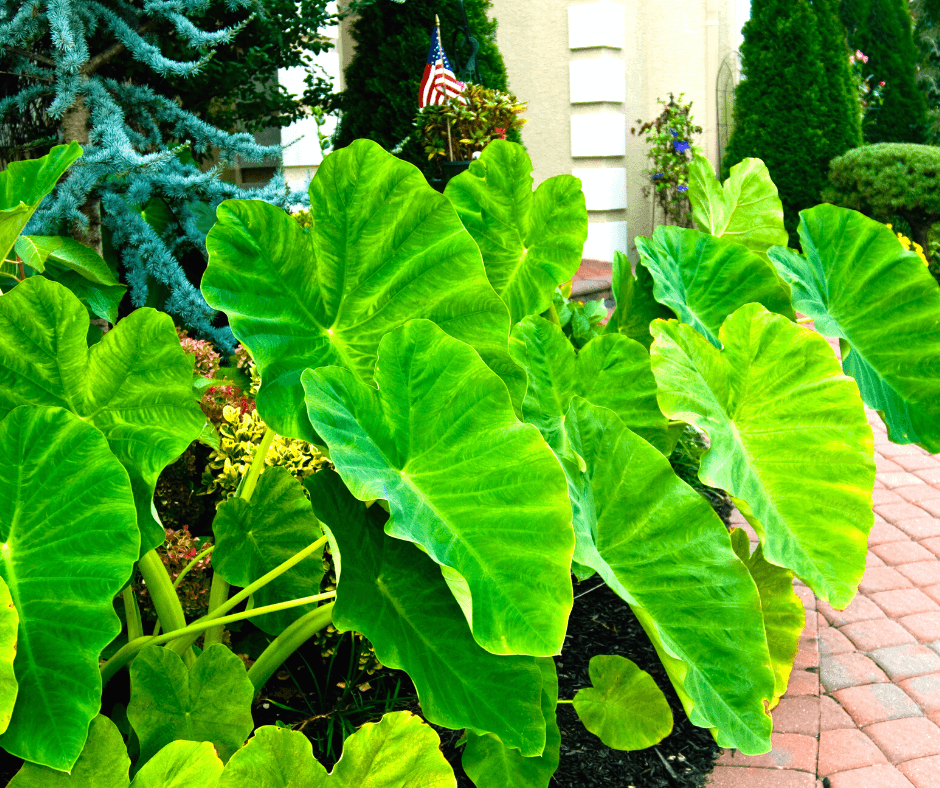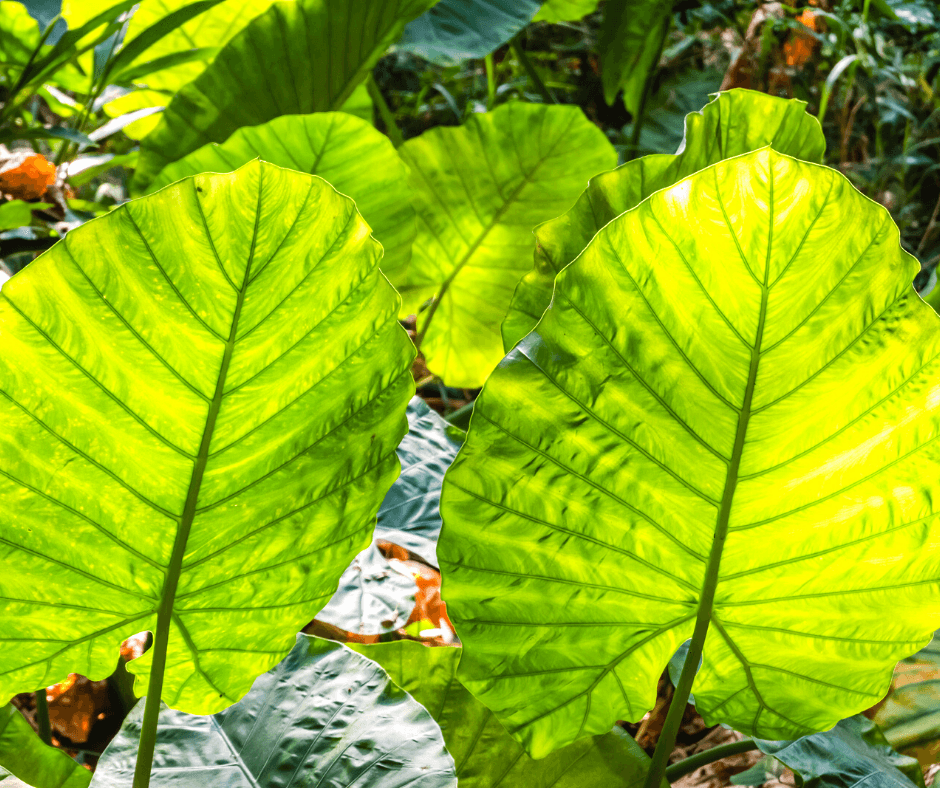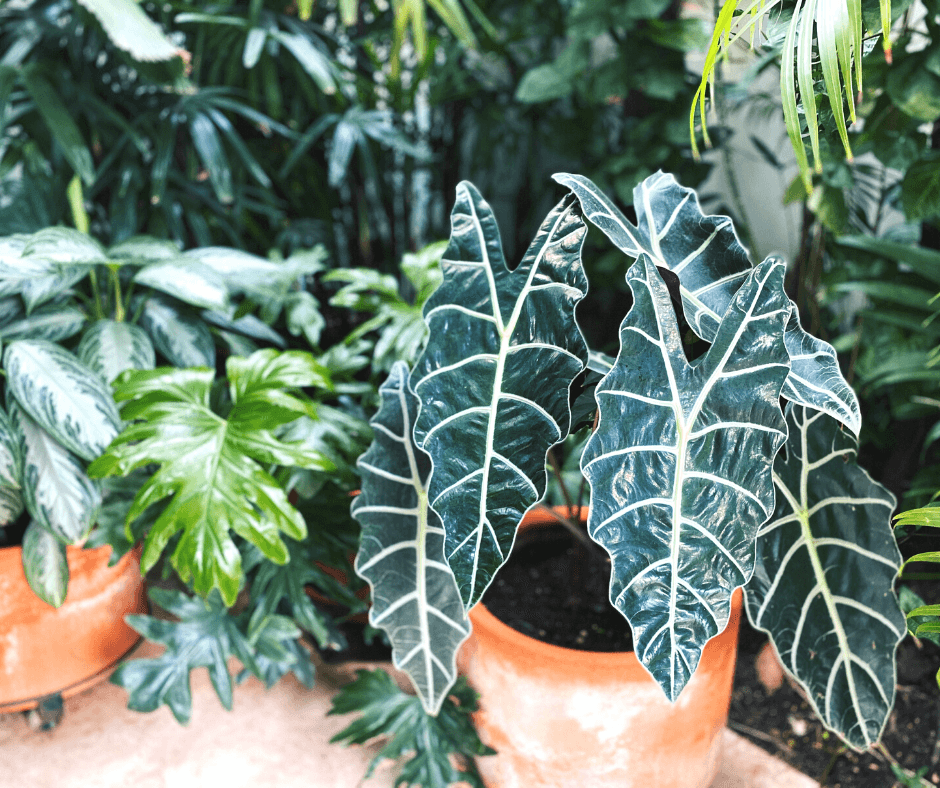
Summer is almost upon us, so it is time to start thinking about what beautiful plants we want to fill our gardens and containers with this year. Usually, I think of flowers, but I am also going to get some beautiful aroids for foliage as well. All are tropical members of the Arum family (Araceae), which is the same family as the eastern native wildflower Jack-in-the-Pulpit, but their show is in their impressive leaves rather than their unusual flowers.
Growing Preferences for Garden Aroids
These aroids grow best in full to part shade, and they like warmth and humidity. This is because many originate from tropical rain forests from around the world, particularly in the Americas. Those mentioned in this article have impressive leaves and rarely flower in temperate regions. The blooms, if they do appear, consist of a single, large petal-like spathe that surrounds a column of flowers called a spadix. (Click here to see a spathe and spadix bloom.)
The plants require constant moisture, without saturation, and loose, well-drained soil. If your soil has low fertility, adding an amendment is recommended. Working ample amounts of Black Gold Canadian Sphagnum Peat Moss into your garden soil will increase its organic matter, helping it drain more quickly but stay moist. Peat also slightly reduces soil pH, which the aroids mentioned here prefer (6.0-7 pH). For container-grown aroids, Black Gold All Purpose Potting Mix is the perfect option.
Caladiums

About Caladiums
For me, the top aroids on the list are caladiums (Caladium hybrids, Zones 9-11), also called angel’s wings. They love full to part shade (more shade is needed in hotter climates) and provide a lot of color to low-light gardens. They range in size from 1 foot to 2.5 feet tall and have 6- to 12-inch leaves. The gorgeous plants have big, heart-shaped, or strap-shaped leaves that come in shades of white, pink, red, and green, most often in a dazzling mix of bright colors on each leaf. Thousands of varieties have been developed since the late 1700s when they were first introduced from South America to Asia, Europe, and the Americas. They are popular garden plants worldwide.
Growing Caladiums
Caladiums are often grown as annuals in the north. This is because they are a challenge to dig and overwinter indoors. They have tuberous roots, somewhat like potatoes, only much smaller. In winter storage, the fleshy roots often die from fungal rot, both tuber rot (Fusarium solani) and root rot (Pythium myriotylum). Despite these challenges, I have read that with special treatment and care the tubers can be overwintered. The key is keeping them warm and lightly moist. An application of copper sulfate fungicide before they go into storage can also help. With this information in hand, I am going to treat mine with fungicide and store them properly this winter to see if I cannot get them to survive until early spring when they can be planted again. In tropical to subtropical areas, Caladiums winter over in the ground and have a short dormant period.

When planting Caladium tubers in the spring, start them indoors in a fresh potting mix. Plant them no more than 2-3 inches deep and 6 inches apart. To encourage more large leaves, remove the large central bud from the tuber while leaving the smaller outside buds to send up leaves. This gives the smaller buds more food from the start, which helps them get bigger faster. After planting them, fertilize with Proven Winners Continuous-Release Plant Food because they are heavy feeders. The 6-month formulation feeds plants throughout the growing season with only one application.
They require warm temperatures of 65-75 degrees F and good humidity. Before planting them outdoors, the days and nights should be warm. This may mean waiting until early June to plant them in northern zones. Tubers that are directly planted in the cold, spring ground will often rot and die.
Caladium Varieties
There are so many wonderful Caladiums to grow! Some excellent varieties include the white ‘Fiesta’ with red veins, dark green ‘Red Flash’ with red veins, and green-faced white ‘June Bride’. The especially colorful ‘Carolyn Whorton’ has light green leaves with splotches of pink and red veins. Some newer varieties have been bred to grow well in the full sun or shade. The best of these are Sun or Shade Caladiums by Proven Winners. The celebratory Sun or Shade Bottle Rocket, with its brilliant red, pink, white, and green leaves, is especially pretty.
Good sources for every Caladium you might want are Caladium World, Caladiums Florida, and Fancy Plants Farm. They are all based in Florida where Caladiums are cultivated, so you know that you will be getting the freshest tubers available. No rot here.
Elephant Ears

About Elephant Ears
There are two other genera of common garden plants related to Caladium that have big, beautiful leaves. They are the elephant ears, Alocasia and Colocasia. One layman’s way to tell them apart is that many common garden Alocasia have leaves that point up and Colocasia have leaves that point down, though this is not always the case. Both have fleshy root structures that are either bulbs, rhizomes, or tubers, depending on the species. The plants naturally spread as they grow and can be separated and replanted each season. They are also nice to share with friends.
Growing Elephant Ears
Unlike Caladiums, elephant ears will generally tolerate more sun, and many like moist or even wet soil. When you plant them outdoors in the warmth of the late spring, mix Black Gold Canadian Sphagnum Peat Moss or Natural & Organic Garden Compost Blend into the soil to increase fertility. Water plants in the ground 2 to 3 times a week and containers daily in the absence of rain. An application of continuous-release plant food will help them take off quickly and feed them through summer.
Like Caladium, before planting elephant ears outdoors, the soil needs to be at least 65 degrees Fahrenheit. To get them going earlier, start them in pots indoors in a warm spot with bright, indirect light. Plan for garden space because elephant ears can get very large. Be sure to use the spacing guidelines provided. Potted elephant ears need large containers; half whisky barrels work well.
Water them well. Do not let the soil dry out, and water when it becomes dry about 1 inch down. Plant the large bulbs 4 to 6 inches deep. In the fall, the bulbs can be dug and overwintered in a cool, dry place. In warmer zones, cut back the leaves, cover the crowns with mulch, and leave the tubers in the ground to overwinter. They should come back next spring.
Elephant Ear Varieties

Giant taro (Alocasia macrorrhizos, Zones 9-11) is cultivated across tropical Asia and has huge green leaves that point upwards. The plants can reach 6-15 feet, depending on the size of the bulb and whether it is being grown in a temperate or tropical climate. Give it a lot of space, water, and care, and you will be rewarded with an impressive garden specimen. Dig and overwinter the bulbs in cold-winter climates.
Portora giant elephant ear (Alocasia ‘Portora’, Zones 7-10) is a hardier and slightly shorter plant that reaches 4-8 feet. It has striking, large, upright green leaves with wavy edges. Grow it like giant taro. Consider protecting it with a layer of mulch in the fall to help it overwinter where hardy.
Polly African mask (Alocasia ‘Polly’, Zones 10-12) is a more compact plant with narrow dark green leaves that have striking white veins and scalloped edges. It looks especially beautiful in containers and also grows well as a house plant.
Black Velvet elephant ear (Alocasia reginula ‘Black Velvet’) is a compact form that reaches just 20 inches tall. It has large, dark leaves with prominent white veins. Each feels like velvet. Grow these in outdoor containers and pot them up as houseplants in the fall. They pair well with colorful begonias. (Click here to read my article about cascading begonias.)

True taro or elephant ear (Colocasia esculenta, Zones 8-10) is the most common of all the elephant ears. It likes full sun to shade and all moist soils, even clay. During dry times, don’t forget to give it 3 to 4 inches of water every week. Mulching also helps to keep in the moisture. Where not hardy, dig them before frost. Lift the bulbs and store them in dry peat moss, in a cool, dark area indoor area. There are lots of very pretty varieties including the purple dappled ‘Mojito‘, bold, upright ‘Coffee Cups’ with its cup-shaped leaves with dark purple veins, and the classic ‘Illustris‘, which has elegant leaves of darkest purple and green veins. ‘Jack’s Giant‘ has all of the looks of the standard taro but it’s really big!
Thai Giant elephant ear (Colocasia gigantea ‘Thai Giant’, Zones 8-10) can get really large, so leave plenty of room outside if you want one. (I plan to grow one this year in a damp spot of the garden.) Mature specimens can reach 9 feet tall with leaf blades that are 5 feet tall and 4 feet wide. It can have scented white flowers as well, but these are less common in temperate climates.
Any of these beautiful aroids will add impressive beauty to the garden. I hope this article has given some gardeners the desire to plant one of these bold, unusual plants. I am buying ‘Thai Giant’ today!
Special Note: There are toxic irritants in the leaves of most aroids, so wear gloves when cutting them. Refrain from planting them if you have pets or small children that might ingest them. Visit the ASPCA to learn more about their toxicity to animals. If someone ingests some, be sure to contact Poison Control.

